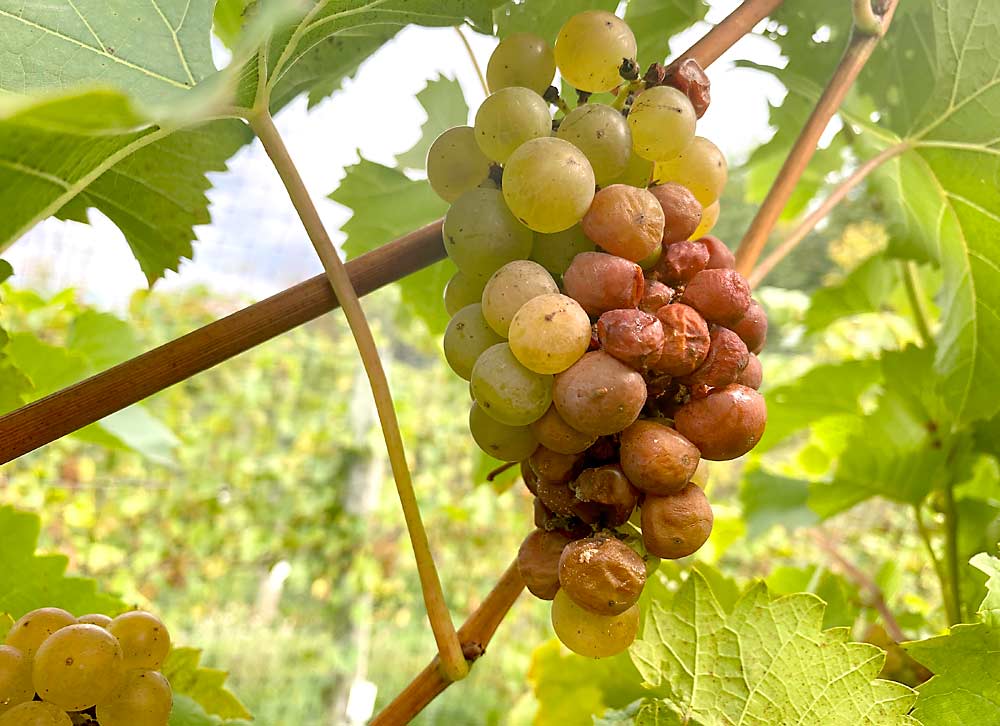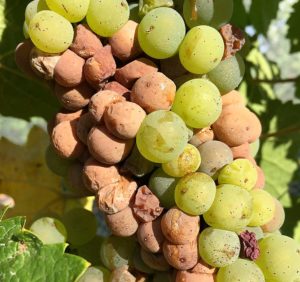
As New York’s grape-growing regions become warmer and wetter, sour rot outbreaks are becoming more frequent and more severe. With funding help from multiple sources, Cornell University researchers are studying the growing problem.
Sour rot — a symptom complex in which infected grape berries become wet and discolored, giving off a pungent vinegar smell that is the result of interactions among several different species of bacteria and yeast — reduces wine grape quality and yields. The need to manage it increases labor and pesticide costs, said Cornell graduate student Rekha Bhandari.
Dave Wiemann, vineyard manager at Sheldrake Point Winery in New York’s Finger Lakes region, said the severity of sour rot depends on the year. Sheldrake Point, which grows about 60 acres of Vitis vinifera varieties, including Riesling, Pinot, Chardonnay and Merlot, has had some “horrible” sour rot outbreaks in recent years, when some blocks lost at least a third of their fruit. Thin-skinned Riesling is especially susceptible.
Cornell entomologist Gregory Loeb said sour rot intensity varies based on weather, variety and other factors. In a dry year like 2020, sour rot is not much of a problem, but it can be “disastrous” in wet and warm years like 2018 and 2021.
Loeb and other Cornell researchers recently received more than $154,000 in funding from the U.S. Department of Agriculture, the New York Wine and Grape Foundation and Northeast Sustainable Agriculture Research and Education to study sour rot. Meanwhile, researchers in Michigan and Pennsylvania are conducting separate studies.
Loeb and Bhandari want to unravel the interactions among microbes and insects associated with the complex. Grape berry moth, yellow jackets and even birds are some of the pests that contribute to the spread of sour rot by damaging fruit and transmitting microbes, Loeb said.
Sour rot tends to be worse when drosophila fruit fly populations are abundant. The common fruit fly (Drosophila melanogaster) transmits microbes that contribute to sour rot, and its larvae disintegrate berries. Evidence suggests the invasive spotted wing drosophila (SWD), which becomes active late in the season and lays eggs in grapes, also plays a role in transmitting microbes, especially when the weather is wet and warm. According to preliminary data, SWD might facilitate fruit access for other drosophila species that don’t possess a serrated ovipositor, Bhandari said.
Evidence is mounting that fruit flies are building up resistance to pyrethroid insecticides. To combat this, Cornell recommends rotating among different modes of action, Bhandari said.
One of the research team’s goals is to optimize chemical control of fruit flies and reduce resistance.
Growers combat sour rot with a combination of insecticides and antimicrobial products. When risk factors line up in warm, wet years, they might spray weekly. In addition to controlling fruit flies and microbes with pesticides, growers can reduce risk of sour rot by opening up the vine canopy for better air circulation and light exposure, and they can harvest slightly earlier than normal, Loeb said.
Loeb and Bhandari are working with Wiemann to narrow down optimum spray timings and frequencies for combatting sour rot. Spraying isn’t cheap, but it can help prevent an even more expensive alternative — physically sorting damaged from undamaged grapes, which takes 10 or more man-hours per acre, Wiemann said.
The critical time to prevent a sour rot outbreak is during and shortly after bloom, Wiemann said. Controlling fungal diseases such as powdery mildew and botrytis early in the season helps prevent berry cracking, which gives growers a better chance of controlling sour rot later in the season. Controlling fruit flies is important, too, because they can swiftly spread sour rot infections.
Wiemann uses Mustang Maxx (zeta-cypermethrin) insecticide and OxiDate (hydrogen peroxide and peracetic acid) fungicide to manage sour rot outbreaks. OxiDate, which he recently started using, will kill bacteria on contact but is not long-lasting. It will take a few years of use to see how well the fungicide actually works, he said.
Some of Loeb’s Cornell colleagues are testing other potential management methods. Grape pathologist Katie Gold said preliminary data show that ultraviolet light treatments can be effective against sour rot, but the results need to be replicated in larger trials. Other Cornell researchers are testing cuticle thickeners to reduce berry cracking. Data have been mixed so far, but cuticle thickeners may help with sour rot in some cases, Loeb said.
“My suspicion is that there is not going to be a single silver bullet to managing sour rot, rather a combination of approaches to minimize impact,” he said.
—by Matt Milkovich







Leave A Comment